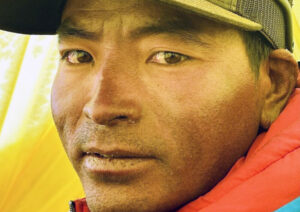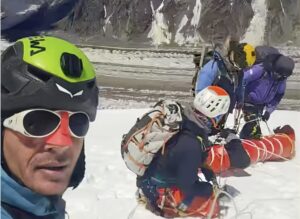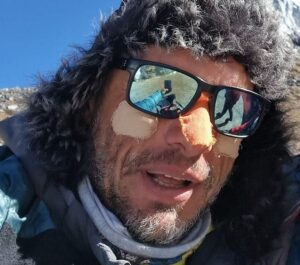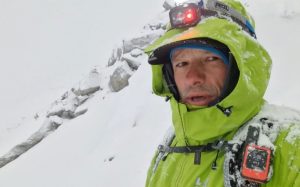The 8,000m season in the Karakorum has almost ended. The K2 summiters should have arrived back in Base Camp today.
Meanwhile, Niels Jespers and Hugo Ayaviri are happily decompressing after their no-O2 summit.

Irina Galay displays the coat of arms of her city of Mukachevo on the summit of K2. Photo: Irina Galay
K2
Madison Mountaineering has published a complete list of its 21 climbers who summited K2 yesterday, some minutes after 6 am. Details to follow.
K2 had a record number of summits this season, but the massive use of bottled oxygen to reduce K2 to a tourist mountain, albeit a still-dangerous one, has disturbed veteran climbers such as Ralf Dujmovits.
“All summiters climbed the Abruzzi Route, and all but three used supplementary oxygen,” Dujmovits noted. “Nobody would have believed it 15 or 20 years ago, but K2 has been tamed into a commercial summit, with the risks and difficulties minimized. What does it mean when climbers start using supplementary oxygen at Camp III (~7,200m) on K2 and follow a broken trail and fixed line to the summit?”
He added: “The two teams that tried a new route or to repeat a rarely climbed route suffered bad luck and tragedy.”

Stephan Keck lost one of his partners in an avalanche on the SE Face of K2. Photo: Stephan Keck
Survivor syndrome
Indeed, Ian Welsted and Graham Zimmerman have safely returned to Base Camp after retreating from the swelteringly hot West Ridge of K2. Meanwhile, the survivors of the bold attempt on a new route up the SE Face lost their third member, Rick Allen, to an avalanche. No details have emerged yet, but according to some in Base Camp, the rescue of the two surviving climbers by a helicopter long line was nearly as dangerous as the new route that they were attempting.
Currently, Jordi Tosas is out of touch while Stephan Keck is back home in the German countryside, managing what he describes as the darkest moments of his life. His raw, personal posts on Instagram hint at the grief he feels losing a climbing partner.
“It’s hard to stand shoulder to shoulder in an avalanche and not know why he had to go and I have to stay,” wrote Keck. “It is all the harder to know that I have to live and still lose everything…”
Another tragic event overshadowed this summer’s K2 summits. First, the discovery of the bodies of the missing climbers from last winter. Second, Sajid Sadpara and his own poignant mission — both summiting K2 for the second time and paying his final respects to his father, Ali Sadpara.

Lakpa Sherpa of Pioneer Adventure and Valentyn Sypavil, owner of Alpomania, atop K2. Photo: Lakpa Sherpa
Among the first climbers on K2 this year were Lakpa Sherpa of Pioneer Adventure and the Ukrainian guide (and owner of Alpomania) Valentyn Sypavin.
Sypavin was also the first person to spot and dig out Juan Pablo Mohr’s body. As he told RussianClimb, “Ali and John were attached by jumars to fixed ropes. They were both without oxygen masks or O2 bottles…The Chilean [JP Mohr] lay just 20 minutes from C4. He walked quickly and maybe went first. I think he just froze on the slope. Maybe he was waiting for [the other] two…”
Broad Peak: Lucero descending, Mohammed, and Batti in BC
Broad Peak’s upper sections are deserted now. Akhbar Syed of Lela Peak Expeditions reports that Ignacio Lucero is returning to Base Camp. He has decided against risking a solo summit try in high avalanche conditions. He started his descent this morning.
Saad Mohammed and Ashif Batti of Pakistan had reached Camp 3 on July 26, and Batti participated in the summit push that failed because of the avalanche danger. They started to go down from Camp 3 yesterday. Mohammed texted uneasily today at around 6 pm Pakistan time:
“At the Japanese Camp I. Almost down now. The mountain told us today what it is made of. We barely survived.”
Earlier, he said that he couldn’t find water or snow for melting in Camp 1 and needed to push further down.
According to reports, they were descending very slowly. It’s currently the middle of the night in Pakistan and the two Pakistani climbers have just arrived, “too tired to tweet,” as one said. No word yet on Lucero, who left C3 today on his own.
British team members Paul Etheridge and Pete Brittleton took part in two unsuccessful summit pushes on Broad Peak. On the first, they gave up their summit to help with “a mountain emergency,” either the safe descent of the ailing Pakistani porter Mustapha or of Anastasia Runova.
The second one, as mentioned, fizzled out for everyone because of the avalanche danger. As mountaineers, they are understandably frustrated, but now they have a clear understanding of what Broad Peak is really like.

British climbers in Broad Peak Base Camp. (Sorry guys, don’t know who’s who.) Photo: Cumbria to K2
Broad Peak bites!
“Neither Pete or I have ever said that Broad Peak is easy, nor have we ever said it’s a walk in the park,” said Etheridge. “But on numerous occasions, we have said that it’s easier than K2, less technical than K2, less demanding than K2, and far easier to acclimatize on than K2. Broad Peak is a hard, dangerous 8,000m mountain with the same objective dangers as any other mountain in the Himalaya.”
Listing pros and cons, they concluded that Broad Peak includes:
- Fantastically sexy vistas, views for miles and miles of the Pakistani Karakorum
- Great Base Camp location in the heart of the Karakorum.
- Staged camps, C1, C2, C3
- Relatively cheap permits, $700
BUT… (in addition to the usual challenges of climbing an 8,000’er without O2)
- Steep, steep terrain right from BC to ABC and Camp 1
- Tiny, shelf-like camping at C1
- Rockfall and risk from ABC
- Long, long days from C2-C3
- A long summit day in excess of 16+ hours
- Cold, harsh camps from C2
- Large crevasses
- No fixed ropes
- No rescue plan in place
“I would wager that none of the above is mentioned in an [outfitter’s] catalog,” the Brits added. “Broad Peak is a hard, relentless mountain ready to bite you in the bum if you are not prepared.”
Gasherbrum: Reports to come?
Gasherbrum climbers are packing up or on their way home. All GI summiters made it safely back to BC, Akhbar Syed said. Yet summit reports are still lacking. Even those who summited Gasherbrum II on July 18 have kept mostly silent.
In fact, we missed one of the expeditions that topped out on GII that day: the Czech team led by Marek Disman and including Karolina Grohova and Roman Balada. At first, we mistakenly thought that they had climbed the mountain a week later.

Czech climbers Marek Disman and Karolina Grohova. Photo: Marek Disman
The Czechs reached Base Camp later than the other teams and, remarkably, summited just nine days after showing up at the Gasherbrum amphitheater. Disman and Grohova summited on July 18, while Roman Balada turned back above C1.
They only had time for a short rotation to Camp 1 and another before joining the summit push with the other teams. They climbed to the top and back with no supplementary O2 and no high-altitude porters.
“Conditions were tougher because of the absence of big teams,” Marek Disman told ExplorersWeb. “Climbing meant a lot of hard work for small teams and individual climbers.”






